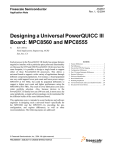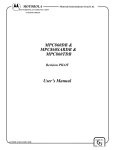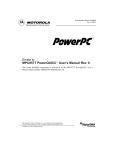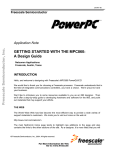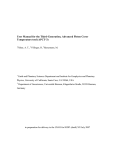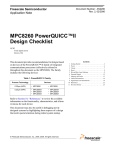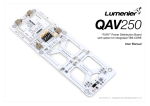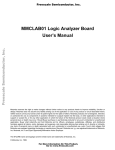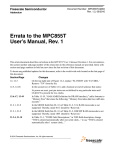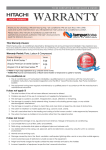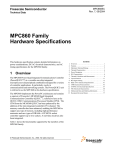Download Technical Bulletin F re e s c a le S e m ic o n d u c to r, I n c . ..
Transcript
Freescale Semiconductor, Inc. Rev 1.0 June 2001 Technical Bulletin Design Considerations / Differences of MPC862SAR Nigel Dick / European FAE Team Netcomm Applications Motorola, East Kilbride, Scotland Freescale Semiconductor, Inc... Section 1.0 Introduction The MPC860SAR and MPC862SAR are both members of the MPC8xx PowerQUICC™ family. In addition to the standard MPC860MH capabilities, the MPC860SAR and MPC862SAR include the universal test and operations physical PHY interface for ATM called UTOPIA. Both devices also provide AAL5 and AAL0, segmentation and re-assembly (SAR) functionality, an ATM pace controller (APC) and transmission convergence (TC) sub-layer for E1/DS1 and xDSL which is implemented by the serial channels. In addition to these features, the allows the user to have simultaneous MII (Media Independent Interface) and UTOPIA capability while still maintaining backwards compatibility with the existing MPC860SAR controller. These particular features make the 862SAR a very adaptable ATM SAR controller that can be used for a variety of ATM applications. Typical examples include: • ATM line card controllers • ATM to WAN interworking (frame relay, T1/E1 circuit emulation, xDSL applications) • ATM25 applications. • Residential broadband network interface units (ATM-to-Ethernet) • High performance set-top controller. • Bridging and routing applications. The MPC862SAR is an enhanced version of the MPC860SAR. Although the MPC862SAR is pin compatible with both the MPC860 and MPC860SAR, a number of small, but significant programming changes have to be made to accommodate differences between the controllers. The MPC857SART is a low cost derivative of the MPC862SAR including the same basic feature set with the exception that only 1 SCC is available to the user. Before selecting the MPC857SART as the host processor, careful consideration should be given as to whether the 1 SCC is capable of providing enough performance for the target application. In this instance, the use of the CPM PERFORMANCE SPREADSHEET given on the Motorola Netcomm web page at “http://www.mot.com/SPS/RISC/netcomm/tools/”, is advised. This document details the main differences in register and control bit settings that need to be taken into account when transitioning from the MPC8XXSAR to the Rev 0 MPC862SAR. The document references the “Enhanced SAR Functionality Supplement to the MPC860 PowerQUICC™ User’s Manual” and the “MPC860 PowerQUICC™ User’s Manual”. Both of these documents are available on the Motorola web site at the following URL: “http://www.mot.com/SPS/RISC/netcomm/docs/pubs/index.html”. 1 For More Information On This Product, Go to: www.freescale.com Freescale Semiconductor, Inc. Rev 0.0 Section 2.0 ATM Enhancements The MPC862 SAR has a number of additional features compared to the original MPC860 (Rev D and earlier revisions) of SAR. Table 1, below, details some of the additional features that the 862SAR processors can now support. Freescale Semiconductor, Inc... Table 1 – Main Functional Differences Between 860SAR & 862SAR ATM Feature Clock frequency UTOPIA interface. Number of priority levels (APC) Memorymemory cell processing? Port to Port switching ? Simultaneo us MII & UTOPIA operation ? ATM APC Queue Handler ? Backwards compatibilit y? UTOPIA Split Mode Capability (8-bit) MPC862SAR MPC860SAR ≤ 25 MHz ≤ 50 MHz 2 Unlimited Yes, Serial loopback only. Yes, Serial or UTOPIA loopback Yes, only with RAM microcode No Yes, no microcode needed! No Not applicable No – 8 Shared data signals only (Mux mode) Yes, when operating UTOPIA in muxed bus (Master) mode ** Yes, PTP queuing mechanism, flexible priority of queues Yes, through the ESAR bits Yes – Mux mode + Split mode (2 separate 8 bit Rx & Tx buses in split mode). * See last paragraph of section 5.1 - Parameter RAM conflicts ** APC Queue errata – this feature is currently broken on Rev E.0. 2 For More Information On This Product, Go to: www.freescale.com Freescale Semiconductor, Inc. Rev 0.0 Section 3.0 ATM Operational Differences In order to highlight some of the operational differences between the 860SAR and the 862SAR, the reception and transmission of a typical ATM cell will be discussed for both processors. Freescale Semiconductor, Inc... 3.1 ATM Cell Reception – 860SAR 1. Cell received from transmission line via UTOPIA interface and put into FIFO. When the RxClav signal (Receive Cell Available) is found to be asserted by the PHY, the SAR will receive a cell from that PHY. 2. Read cell header. In SAR mode, the UTOPIA is controlled by microcode that uses 4 byte long registers. Hence, when the RxClav is sent to the CPM, the cell is read in to the processor four bytes at a time. 3. Address Look-up. Match the header to get the correct channel number. 4. Get parameters from memory. 5. Read data from PHY UTOPIA interface to the CPM. This involved calculating the CRC (Cyclic Redundancy Check) and also sending out the relevant address to the DMA for memory access. 6. The relevant parameters in memory are updated - Buffer descriptor pointers, CRC counters etc. 3.2 ATM Cell Reception – 862SAR 1. Cell received from transmission line via UTOPIA interface and put into FIFO When the RxClav signal (Receive Cell Available) is found to be asserted by the PHY, the SAR will receive a cell from that PHY. 2. Read cell header. In 862SAR, there is a UTOPIA hardware block that reads the entire cell into an internal 2 cell FIFO in a minimal amount of time. Hence, when the RxClav is sent to the CPM, the cell (n bytes) is read in to the processor within (n) clock cycles. 3. Address Look-up. Match the header to get the correct channel number. 4. Get parameters from memory. 5. Read data from PHY UTOPIA interface to the CPM. This involved calculating the CRC (Cyclic Redundancy Check) and also sending out the relevant address to the DMA for memory access. 6. The relevant parameters in memory are updated i.e. Buffer descriptor pointers, counters etc. The most noticeable difference between the 860SAR and 862SAR modes of operation is the actual implementation of how the whole cell is read into the CPM by the UTOPIA interface during cell reception. On the 860SAR, the UTOPIA interface is controlled by microcode. However, the 862SAR has a cell FIFO that is implemented by the UTOPIA hardware block and is independent from any microcode. This added 862SAR functionality requires some additional processing overheads although reading a cell takes a significantly shorter period of time on 862SAR compared to 860SAR. For example, when the 860SAR reads a complete ATM cell of 53 bytes it takes between 300 – 500 CPM clock cycles depending on available bandwidth. The 862SAR, on the other hand, requires around 15-20% less clock cycles and is therefore much more efficient in terms of speed and bandwidth utilized. 3 For More Information On This Product, Go to: www.freescale.com Freescale Semiconductor, Inc. Rev 0.0 3.4 ATM Cell Transmission – 860SAR / 862SAR Freescale Semiconductor, Inc... The user-defined APC scheduler controls this process (assume IAQ bit is not set). The PHY will assert the TxClav signal (transmit cell available) when space is available in the PHY. If the APC is ready to transmit and space is available in the FIFO’s, the cell is transmitted. 1. If a cell is available (TxClav is asserted) and the APC scheduler is ready to transmit, then the channel number is read from the APC transmit queue. 2. Read channel parameters – buffer descriptors, counters etc. 3. Transmit header. If the cell to be transmitted is an AAL5 cell then the information resides in connection tables and parameter RAM. If the cell to be transmitted is an AAL0 cell then the information resides in memory. 4. Transmit payload. This includes direct memory access (DMA) from the buffers with optional cyclic redundancy check (CRC). 5. Update parameters – parameter table entries. 4 For More Information On This Product, Go to: www.freescale.com Freescale Semiconductor, Inc. Rev 0.0 Section 4.0 Programming Considerations In order to take advantage of the new features contained on the 862SAR device, a number of significant programming considerations must be taken into account. This is often a fundamental cause of many 860SAR/862SAR software bugs. Freescale Semiconductor, Inc... • SCC Parameter RAM. Page 4 of this memory area contains all of the necessary connection tables, buffer descriptors and data buffers required for 862SAR operation. Hence, this section of memory MUST be cleared during the initialization sequence prior to any 862SAR operation otherwise the 862SAR may not operate / may operate unpredictably. • In order to enable backwards compatibility i.e. perform 860SAR functionality using 862SAR silicon, ALL ESAR bits must be cleared through the ESAR register set. The reason for this is to reduce the complexity of the internal microcode. Thus, the ESAR bits in registers SRSTATE, STSTATE, APCST should all be cleared. Similarly, if 862SAR functionality is required these bits should be set in all of the above registers. • The 862SAR device allows the user to program or modify any memory location on the fly without conflicting with the current CPM process. It is only possible to do this using the WRITE_TO_MEMORY command. Attempting to modify any memory location without using this command will cause system CPM failure. [Adding / removing internal channels and modifying the APC period can also be changed on-the-fly in both 860SAR and 862SAR modes. Consult the supplementary 862SAR documentation at the following URL “http://www.mot.com/SPS/RISC/netcomm/docs/pubs/index.html”, for further details]. • Customers should also be aware of a possible required software change in transitioning from the MPC862SAR Rev 0 to Rev A when using the Port–to–Port functionality. In Rev 0, customers should ensure that the TB_PTR field inside any TCT (transmit connection table) used for PTP (Point to Point connections) are initialised in the following manner: The upper 16 bits (starting at offset 0x08 in the TCT) must be set to the same value as the receive buffer descriptor base pointer value (RBD_PTR). The lower 16 bits (starting at offset 0x0A in the TCT) must be cleared. This change will allow compatibility between revisions 0 and A. Software that is not initialised in this manner for Port-to-Port applications may exhibit erratic behaviour. • Customers planning to use silicon Rev A should avoid writing non-zero values to the 32 bit location IMMR+0x3CB8, even for non-ATM applications, unless specifically required by Motorola. Rev A will reserve this location for internal CPM usage. 5 For More Information On This Product, Go to: www.freescale.com Freescale Semiconductor, Inc. Rev 0.0 Section 5.0 862SAR Mode - Internal Resource Conflicts When operating an ATM application in 862SAR mode, the MPC862SAR loses some functionality due to internal resource conflicts. The following section details potential restrictions and conflicts that can arise. 5.1 Parameter RAM Conflicts Freescale Semiconductor, Inc... As 862SAR mode requires additional memory, users should be aware of the potential conflicts that can occur in parameter RAM. If operating in serial ATM mode on SCC1-4 or UTOPIA on SCC4, this will cause other peripherals to lose their parameter RAM. The serial ATM parameters of SCC1 extend into the I2C parameter RAM. Similarly, the parameter RAM for SCC2/SPI, SCC3/SMC1 and SCC4/SMC2/PIP is affected in the same manner. In order to relocate the parameter RAM for the SMC’s, I2C and SPI controllers to a non-conflicting location, RAM- based microcode patches can be used. These microcode patches are available on the Motorola MPC8xx website - http://www.mot.com/SPS/RISC/netcomm/tools/”. (On MPC862 the relocation of the I2C/SPI does not require a RAM microcode patch. the device contains the relocatable I2C/SPI functionality and works as described in the pdf for the RAM loadable microcode of previous revisions.) [On MPC862 Rev 0, a current bug in the implementation of the microcode means that when RAM microcodes are enabled, all information in the ROM microcode is lost at locations >=0x2000. The net result is that ATM functionality of the device is effectively lost. Currently no workaround exists although this bug should be resolved on silicon revision A.] 5.2 IDMA2 Conflicts IDMA2 can only be used in level-sensitive mode when ATM is enabled. In order to achieve this mode, the user is required to set the RCCR[DR1M] bit. 5.3 UTOPIA Conflicts The UTOPIA interface is implemented using the hardware of IDMA1 and the parameter RAM page of SCC4. Therefore, if the UTOPIA port is used: • SCC4 is unavailable due to the loss of parameter RAM page 4. • IDMA1 is unavailable. (The DREQ0 signal is lost, and the IDMA1 event and mask registers IDSR1 and IDMR1 are used for UTOPIA events.) • Ethernet CAM support for SCC2, SCC3, and SCC4 is unavailable (due to the loss of REJECT2, REJECT3, and REJECT4) • Parallel interface port (PIP) is unavailable (due to the loss of the PIP handshake signals) The UTOPIA interface can also be made to operate in either UTOPIA split bus mode of operation or using master mode operation. Depending on initial register programming, specific port pin functions become available or unavailable to the user: In 862SAR multi-PHY mode: 6 For More Information On This Product, Go to: www.freescale.com Freescale Semiconductor, Inc. Rev 0.0 • In UTOPIA split bus mode, PCMCIA port A and the Fast Ethernet controller’s (FEC) MII signals are unavailable. However in UTOPIA muxed bus mode, the MII signals or the PCMCIA port A signals are still available on the PCMCIA port A pins. In 862SAR multi-PHY mode: Freescale Semiconductor, Inc... • The PHY address signals conflict with the signals of both SMCs. However, when a PHY address signal is not activated, the pin’s other signal functions become available. For example, if only eight PHYs are used in a UTOPIA master application, the SMC1 data signals are still available. 7 For More Information On This Product, Go to: www.freescale.com Freescale Semiconductor, Inc. Rev 0.0 Section 6.0 Pin Assignment Comparison Between MPC860 & MPC862SART The table below illustrates the pin assignment differences between the MPC860 and the MPC862SART. The Italic text displayed in green indicates 862SAR specific modes of operation. Freescale Semiconductor, Inc... PIN NAME A2 CS1 A3 CE2_A/MII-TXD3 A4 CS4 A5 WE3/BS_B3/PCWE COMMENTS PIN NAME 862SAR Simultaneous B1 UPWAITB/GPL_B4 MII / UTOPIA operation. B2 RD/WR B3CE1_A/MII-TXD2 A6 WE1/BS_B1/IOWR A7 BS_A2 A8 VDDL A9 A31 A10 A28 A11 A30 A12 A29 A13 A27 A14 A14 A15 A11 A16 A7 A17 A5 A18 A2 B4 CS5 B5 GPL_A2/GPL_B2/CS2 B6 WE2/BS_B2/PCOE B7 MII_CRS B8 BS_A3 B9 TSIZ0/REG B10 A22 B11 A23 B12 A21 B13 A17 B14 A13 B15 A10 B16 A6 B17 A4 B18 A1 B19 A0 C1 UPWAITA/GPL_A4 C2 TA C3 CS0 C4 CS7/CE(2)B C5 GPL_A3/GPL_B3/CS3 C6 OE/GPL_A1/GPL_B1 C7 WE0/BS_B0/IORD C8 BS_A1 C9 TSIZ1 C10 A26 C11 A24 C12 A20 C13 A16 C14 A12 C15 A9 C16 A3 C17 PB[31]/REJECT1/SPISEL C18 PA[15]/RXD1 D1 TEA D2 BDIP/GPL_B5 D3 GPL_A5 D4 CS2 D5 CS6/CE(1)B D6 N/C D7 GPL_A0/GPL_B0 D8 BS_A0 D9 A18 D10 A25 D11 A19 D12 A15 D13 N/C D14 N/C D15 A8 D16 PC[15]/DREQ0/RTS1/L1ST1/Rxclav D17 PA[14]/TXD1 D18 PC[14]/DREQ1/L1ST2 COMMENTS 862SAR Simultaneous MII / UTOPIA operation. 8 For More Information On This Product, Go to: www.freescale.com Freescale Semiconductor, Inc. Rev 0.0 D19PB[28]/SPIMISO/BRGO4 E1 BB E2 BG E3 BI E4 CS3 E5 VDDH E6 VDDH E7 VDDH E8 VDDH E9 VDDH E10 VDDH E11 VDDH E12 VDDH E13 VDDH E14 VDDH E15 VDDH E16 PB[29]/SPIMOSI E17 PA[13] E18 PC[13]/L1RQB/L1ST3 E19 PB[27]/I2CSDA/BRGO1 F1 BURST F2 CR/IRQ3 F3 TS F4 VDDH F5 VDDH F6 GND F7 GND F8 GND F9 GND F10 GND F11 GND F12 GND F13 GND F14 GND F15 VDDH F16 VDDH F17 PA[12] F18 PC[12]/L1RQA/L1ST4 F19PB[26]/I2CSCL/BRGO2 G1 IP_B3/IWP2/VF2 G2 IP_B4/LWP0/VF0 G3 FRZ/IRQ6 G4 BR G5 VDDH G6 GND G7 GND G8 GND G9 GND G10 GND G11 GND G12 GND G13 GND G14 GND G15 VDDH G16 PA[11]/L1TXDB G17 TDO/DSDO G18 TMS G19 TRST H1 IP_B7/PTR/AT3 H2 IP_B0/IWP0/VFLS0 H3 RSV/IRQ2 H4 MII_COL H5 VDDH H6 GND H7 GND H8 GND H9 GND H10 GND H11 GND H12 GND H13 GND H14 GND H15 VDDH H16 TCK/DSDK H17 TDI/DSDI H18 MII_MDIO H19 VDDL J1 ALE_B/DSCK/AT1 J2 IP_B2/IOIS16_B/AT2 K1KR/IRQ4/RETRY/SPKROUT K2 ALE_A/MII-TXD1 J3 IP_B1/IWP1/VFLS1 J4 IP_B5/LWP1/VF1 J5 VDDH J6 GND J7 GND J8 GND J9 GND K3 IP_B6/DSDI/AT0 K4 BADDR30/REG K5 VDDH K6 GND K7 GND K8 GND K9 GND Freescale Semiconductor, Inc... C19 PB[30]/SPICLK/RSTRT2 862SAR Simultaneous MII / UTOPIA operation 9 For More Information On This Product, Go to: www.freescale.com Freescale Semiconductor, Inc. Rev 0.0 J10 GND J11 GND J12 GND J13 GND J14 GND J15 VDDH J16PB[25]/SMTXD1/RXADDR3 862SAR Multi-PHY mode operation only / TXADDR3 J17 PA[10]/L1RXDB J18PB[24]/SMRXD1/TXADDR3 862SAR Multi-PHY mode operation only /RXADDR3 J19 PC[11]/CTS1 Freescale Semiconductor, Inc... L1 MODCK1/OP2/STS L2 OP1 L3 AS L4 OP0/MII-TXD0/UtpClk_Aux 862SAR Simultaneous MII / UTOPIA split bus operation. L5 VDDH L6 GND L7 GND L8 GND L9 GND L10 GND L11 GND L12 GND L13 GND L14 GND L15 VDDH L16PB[20]/SMRXD2/L1CLKOA 862SAR Multi-PHY mode operation only /TXADDR0/RXADDR0 L17 PA[8]/L1RXDA L18 PC[9] L19PB[22]/SMSYN2/SDACK2/ 862SAR Multi-PHY mode operation only TXADDR4/RXADDR4 N1 EXTAL N2 EXTCLK N3 TEXP N4 HRESET N5 VDDH N6 GND N7 GND N8 GND N9 GND N10 GND N11 GND N12 GND N13 GND N14 GND N15 VDDH K10 GND K11 GND K12 GND K13 GND K14 GND K15 VDDH K16PB[21]/SMTXD2/L1CLKOB/TXADDR1/ RXADDR1 K17PB[23]/SMSYN1/SDACK1/TXADDR2/ RXADDR2 K18 PA[9]/L1TXDA 862SAR Multi-PHY mode operation only 862SAR Multi-PHY mode operation only K19 PC[10]/CD1/TGATE1 M1 VDDL M2 BADDR29 M3 BADDR28 M4OP3/MODCK2/DSDO M5 VDDH M6 GND M7 GND M8 GND M9 GND M10 GND M11 GND M12 GND M13 GND M14 GND M15 VDDH M16PC[7]/L1TSYNCB/SDACK2 M17 PA[6]/BRGCLK1/TOUT1/CLK2 M18 PC8/TGATE2 M19PA[7]/CLK1/TIN1/L1RCLKA/BRGO1 P1 XTAL P2 SRESET P3 RSTCONF P4 VDDH P5 VDDH P6 GND P7 GND P8 GND P9 GND P10 GND P11 GND P12 GND P13 GND P14 GND P15 VDDH 10 For More Information On This Product, Go to: www.freescale.com Freescale Semiconductor, Inc. Rev 0.0 862SAR Multi-PHY N16 PB[16]/L1RQA/L1ST4/TXADDR mode operation only 0/RXADDR0 862SAR Multi-PHY N17 PB[18]/L1ST2/RTS2/RXADDR4 mode operation only /TXADDR4 N18 PA5/CLK3/TIN2/L1TCLKA/BRG OUT2 N19 PB[19]/L1ST1/RTS1 Freescale Semiconductor, Inc... R1 KAPWR R2 PORESET R3 WAIT_A/SOC_Aux R4 WAIT_B P16 VDDH P17PA[3]/CLK5/TIN3/BRGOUT3 P18PB[17]/L1RQB/L1ST3/TXADDR1/RXA 862SAR Multi-PHY mode operation only DDR1 P19 PA[4]/TOUT2/CLK4 T1 VDDSYN T2 XFC 862SAR Simultaneous T3IP_A7/UTPB_Aux7/MII-RXDV MII / UTOPIA split bus operation. T4IP_A1/UTPB_Aux1/MII-RXD2 R5 VDDH T5IP_A0/UTPB_Aux0/MII-RXD3 R6 VDDH T6IP_A6/UTPB_Aux6/MII-TX-ERR R7 VDDH R8 VDDH R9 VDDH R10 VDDH R11 VDDH R12 VDDH R13 VDDH R14 VDDH R15 VDDH R16 PD[12]/L1RSYNCB/MIIMDC/UTPB3 T7 D31 T8 D25 T9 D22 T10 D15 T11 D9 T12 D17 T13 D12 T14 VDDH T15 PD[7]/MII-RX-ERR/UTPB4 T16 PD[11]/MII-TX-ERR RXD3/RXENB Available only in simultaneous MII & UTOPIA operation R17 PB[15]/BRGO3/Txclav R18PA[2]/CLK6/TOUT3/L1RCL KB/BRGCLK2 R19 PC[6]/L1RSYNCB T17 PC[4]/L1RSYNCA T18PC[5]/L1TSYNCA/SDACK1 U1 VSSSYN U2 N/C U3IP_A2/IOIS16_A/UTPB_Aux 862SAR Simultaneous MII / UTOPIA 2/MII-RXD1 operation. 862SAR Simultaneous U4IP_A4/UTPB_Aux4/MIIMII / UTOPIA RXCLK operation. U5IP_A5/UTPB_Aux5/MII-RX- 862SAR Simultaneous MII / UTOPIA ERR operation. U6 D30 U7 D26 V1 VSSSYN1 V2 N/C V3 DP0/IRQ3 862SAR Simultaneous MII / UTOPIA operation. 862SAR Simultaneous MII / UTOPIA operation. 862SAR Simultaneous MII / UTOPIA operation. 862SAR Simultaneous MII / UTOPIA operation. Available only in simultaneous MII & UTOPIA operation T19 PA[1]/CLK7/TIN4/BRGO4 V4 DP3/IRQ6 V5 DP1/IRQ4 V6 D28 V7 D24 11 For More Information On This Product, Go to: www.freescale.com Freescale Semiconductor, Inc. Rev 0.0 U8 D21 U9 D19 U10 D16 U11 D11 U12 D23 U13 D8 U14 IRQ1 U15 PD[5]/MIITXD3/REJECT2/UTPB6 U16 PD[4]/MIITXD2/REJECT3/UTPB7 Freescale Semiconductor, Inc... U17PD[15]/L1TSYNCA/MIIRXD3/UTPB0 Available only in simultaneous MII & UTOPIA operation Available only in simultaneous MII & UTOPIA operation Available only in simultaneous MII & UTOPIA operation V8 D20 V9 D18 V10 D14 V11 D10 V12 D27 V13 D13 V14 IRQ0 V15 MII_TX_EN V16 PD[6]/MII-RXDV/RTS4/UTPB5 V17 PD[9]/MII-TXD0/RXD4/UTPCLK U18PB[14]/RSTRT1/RXADDR2 V18PD[13]/L1TSYNCB/MII-RXD1/UTPB2 U19PA[0]/CLK8/TOUT4/L1TCL KB V19PD[14]/L1RSYNCA/MII-RXD2/UTPB1 W2IP_A3/UTPB_Aux3/MIIRXD0 W3 CLKOUT W4 DP2/IRQ5 W5 D29 W6 D7 W7 D6 W8 VDDL W9 D5 W10 D3 W11 D2 W12 D1 W13 D4 W14 D0 W15 IRQ7/MII_TXCLK W16 PD[3]/MII-TXD1/SOC W17 PD[8]/TXD4/MIIRX_CLK/MII-MDC W18 PD[10]/TXD3/MIIRXD0/TXENB Available only in simultaneous MII & UTOPIA operation Available only in simultaneous MII & UTOPIA operation Available only in simultaneous MII & UTOPIA operation Available only in simultaneous MII & UTOPIA operation 862SAR Simultaneous MII / UTOPIA operation. Available only in simultaneous MII & UTOPIA operation Available only in simultaneous MII & UTOPIA operation 12 For More Information On This Product, Go to: www.freescale.com Freescale Semiconductor, Inc. 7.0 Register Comparison Between 860SAR & 862SAR The following spreadsheets detail the differences between 860SAR and 862SAR throughout the register set of the MPC8XX: Connection Tables SAR vs ESAR Receive Function Code & Status Register Freescale Semiconductor, Inc... Base 0 1 2 Field 3 4 5 BO 6 7 FC 8 9 10 11 12 13 14 15 EXT ACP EC* SNC* ESAR MCF SER MPHY * 8 9 13 ESAR Must also be set to enable ESAR functionality MCF Enable management cell filter * Available only in SCC4 UTOPIA mode; otherwise written as 0 Transmit Function Code & Status Register Base 0 1 2 Field 3 4 5 BO ESAR 6 7 FC EXT 10 11 12 EC* SNC* ESAR 10 11 14 15 SER MPHY * Must also be set to enable ESAR functionality * Available only in SCC4 UTOPIA mode; otherwise written as 0 APC Status Registe r Base Field 0 1 CSE R 2 3 NSE R 4 5 6 * 7 8 9 ** For More Information On This Product, Go to: www.freescale.com 12 13 14 15 ESAR DIS PL2** * MHY Freescale Semiconductor, Inc. ESAR * ** PL2*** Must also be set to enable ESAR functionality Was NMPHY on SAR, now bits [2..6] in MPHY status register on ESAR Was CMPHY on SAR, now bits [10..14] in MPHY status register on ESAR Used only if ESAR is not set for backwards compatibility with the MPC860SAR Freescale Semiconductor, Inc... MPHY Status Registe r Base 0 1 2 3 Field 4 5 6 7 8 9 10 11 NMPH Y NMPHY CMPHY 12 13 14 15 13 14 15 CMPH Y Number of Multiple PHY's Current Multiply PHY CPM Comm and Registe r Base Field 0 RST ATM OPCOD E OPCODE 2 1 2 ATM OPCODE 3 4 5 6 7 OPCODE=1111 8 9 10 11 CH_ NU M 111 = ATM ESAR Write to Memory Command or internal command (see OPCODE 2) 00 = RESERVED, normal ATM OPCODES apply when 00 is written to these two bits 01 = ACTIVATE PM - to activate PM session on the channel number specified by the COMM_CH field. * 10 = DEACTIVATE PM - To deactivate PM session on the channel number specified by the COMM_CH field. * 11 = RE SE RV ED * OPCODE 2 commands are only valid when ATM OPCODE=111 For More Information On This Product, Go to: www.freescale.com 12 OPC OD E2 FLG Freescale Semiconductor, Inc. ESAR APC Status Register (From APC Parameter RAM) Base Field 0 APCOM Freescale Semiconductor, Inc... * 1 * 2 3 LAST * 4 5 6 7 8 9 10 11 12 13 14 15 EQ ESAR DIS * MPHY Rese rved APCOM APC table overrun event mask for this APC level. LAST This priority level is the last APC level for the specific PHY#. EQ APC table and PTP queue of this specific level have equal priority. The APC mechanism will schedule cells to be transmitted evenly from the twoutilities.This bit is valid only if the DIS bit is NOT set. ESAR Selects the new features of ESAR or allows backward compatibility with the older SAR functionality. To enable ESAR functionality, all bits must be programmed to the desired value throughout the ESAR register set. DIS APC table is disabled at this level. PTP queue will still be serviced. All lower levels down to LAST will still be serviced. Can only be set on the fly using the “write to memory” commandPge ( 4-22 of ESAR spec) to avoid conflict. MPHY All M-PHY bits (throughout the ESAR register set) should be set to desired values when working withmulti-PHY. UTOPIA Mode Event Register Base 0 1 Field 2 3 4 5 6 GUN SYN IQOV GINT GUN C Global transmitter underrun in UTOPIA's tx cell FIFO. GOV Global receiverunderrun in UTOPIA's rx cell FIFO. 7 GOV Interrupt Queue Entry For More Information On This Product, Go to: www.freescale.com Freescale Semiconductor, Inc. Base 1 Field W 2 3 4 5 6 7 CNG 8 9 APC0 10 11 12 13 14 15 TQF UN RXF BSY TXB RX B Transmit queue full - this bit is valid in case that an APC bypass command was issued and the Transmit queue is full, indicating that the APC bypass command was notperformed.This bit is valid only for AAL0 PTP channels where ITQ option is set. Freescale Semiconductor, Inc... Performance Monitoring Section 4.3 covers this new feature for ESAR. Correct configuration is achieved by programming table 4-2. Connection Tables - SAR vs ESAR Receive Connection Table - RCT Base 0 CT_Offset + 0 FHN T PM NCR C PTP CT_Offset + 2 CT_Offset + 4 2 3 4 5 6 7 8 9 10 11 12 13 14 HEC CLP CNG/ NCR C INF CNGI /PT P CDIS AAL Performance Monitoring No CRC (AAL0 only) / Congestion (AAL5 only) Port to Port cell switching / Congestion interrupt (AAL5 only) RBAL EN RCR C CT_Offset + 6 CT_Offset + 8 RB_P TR CT_Offset + A CT_Offset + C CT_Offset + E CT_Offset + 10 RTML EN RBD_ PTR RBA SE For More Information On This Product, Go to: www.freescale.com 15 Freescale Semiconductor, Inc. CT_Offset + 12 CT_Offset + 14 TSTA MP AAL2 AAL2 CT_Offset + 16 FT FT NIM RPM T IMAS K Indicates this VC is an AAL2 channel. Must initialise prior tosetting ! NIM RPM T Filter Type Non intrusive monitoring Receive performance monitoring table number CT_Offset + 18 Freescale Semiconductor, Inc... to Reserv ed CT_Offset + 1F Port to Port Specific Receive Connection Table - PTP RCT When PTP function is used a new RCT must be defined called PTP RCT. It is a specific RCT which must be initialized as page 2-15. All of the fields are new. Transmit Connection Table - TCT Base 0 2 3 4 5 6 CT_Offset + 20 CT_Offset + 24 8 PC PM CT_Offset + 22 7 9 10 11 12 13 14 INF CR10 CDIS AAL 15 Performance Monitoring TBAL EN TCR C CT_Offset + 26 CT_Offset + 28 TB_P TR CT_Offset + 2A CT_Offset + 2C CT_Offset + 2E CT_Offset + 30 TTML EN TBD_ PTR TBA SE CT_Offset + 32 TPM TPM T Transmit Performance monitoring table number For More Information On This Product, Go to: www.freescale.com AVC F ACT Freescale Semiconductor, Inc. T AVC F Auto VC off Active Statu s ACT CT_Offset + 34 CHE AD CT_Offset + 36 CT_Offset + 38 APCL CT_Offset + 3A APC PR OUT Freescale Semiconductor, Inc... CT_Offset + 3C CT_Offset + 3E TSE R APC P BNR Buffer Not Ready (Internal Use) TSER VICE APC P APC PF Traffic service type APCP <= 4094 instead of 32766 in SAR Transmit connection Table Extensions TCTE Located at TCTEBASE programmed in Parameter RAM, the TCTE are located in DPRAM. They support VBR channels to hold additional parameters for traffic shaping. Buffer Descriptors - SAR vs ESAR Receive Buffer Descriptor Base 0 2 3 4 5 6 7 8 9 10 11 Offset + 0 E W I L F/OA M CM FMC HEC CLP CNG ABT Offset + 2 F/OA M F (AAL5) First in Frame. OAM (AAL0) Operation and Maintenance cell indication. FMC Forward Monitoring Cell received + BRC fields added 12 DATA LENGTH / Channel Code Data Number of bytes written into BD's data buffer (AAL5) lengt h Chann Channel number when AAL0 buffers + MCF bit set el For More Information On This Product, Go to: www.freescale.com 13 14 15 LN CR Freescale Semiconductor, Inc. Code Offset + 4 Offset + 8 Offset + A Offset + C Offset + 10 Freescale Semiconductor, Inc... Offset + 14 RX DATA BUFFER POINTER CPCSUU+ CPI RESE RVE D CELL HEADER EXPANSION 1 CELL HEADER EXPANSION 2 CELL HEADER EXPANSION 3 Transmit Buffer Descriptor Base 0 2 3 4 5 6 Offset + 0 R W I L OAM CM OAM User Cell / Non User Cell ICNG Invert CNG bit (AAL5 only) RH ICLP Offset + 2 Offset + 4 Offset + 8 Offset + A Offset + C Offset + 10 Offset + 14 7 8 9 10 11 12 Replace header (AAL5 only) Invert CLP bit (AAL5 only) DATA LEN GTH TX DATA BUFFER POINTER CPCS-UU+CPI/HEADER_L HEAD Lower half word of the replacement header ER_L Reserved/HEAD ER_H HEAD Upper half word of the replacement header ER_ H CELL HEADER EXPANSION 1 CELL HEADER EXPANSION 2 CELL HEADER EXPANSION 3 Parameter RAM Mapping - SAR vs ESAR For More Information On This Product, Go to: www.freescale.com 13 14 15 ICNG RH ICLP Freescale Semiconductor, Inc. Serial and Utopia Interface Parameter RAM Map Freescale Semiconductor, Inc... Offset from SCC Base Name Description 0x00 RBDBASE Base pointer for receiveBDs 0x04 SRFCR/SRSTATE SAR receive function code and receive status 0x06 MRBLR Maximum receive buffer length 0x08 RSTATE SCC internal receive state parameters 0x0C Reserved 0x10 R_CNT 0x12 STFCR/STSTATE SAR Function ESAR Function SRFCR/SRSTAE[12] does not exist SRFCR/SRSTAE[12]= ESAR bit Enable ESAR functions SRFCR/SRSTAE[13]= DIS Disable Utopia receive process SRFCR/SRSTAE[13]= MCF Enable management cell filter STFCR/STSTATE[9] = TQF Transmit Queue Full in 850SAR 850 ESAR doesn't exist STFCR/STSTATE[9] = Reserved in 860SAR until Rev C1 STFCR/STSTATE[9] = Reserved STFCR/STSTATE[9] = TQF Transmit Queue Full in 860SAR in Rev D STFCR/STSTATE[9] = Reserved STFCR/STSTATE[11] = PBF Port B Flag STFCR/STSTATE[11] = Reserved STFCR/STSTATE[12] = Reserved STFCR/STSTATE[12] = ESAR Enable ESAR functions Receive internal byte counter 0x14 TBDBASE Base pointer for transmitBDs 0x18 TSTATE SCC internal transmit state parameters 0x1C COMM_CH Command channel 0x1E STCHNUM Current transmit channel number 0x20 T_CNT Transmit internal byte counter 0x22 CTBASE Connection table base address 0x24 ECTBASE External connection table base address 0x28 INTBASE Interruput base pointer 0x2C INTPTR Pointer to interrupt queue 0x30 C-MASK Constant mask for CRC32 0x34 SRCHNUM Current receive channel number 0x36 INT_CNT Interrupt counter For More Information On This Product, Go to: www.freescale.com Freescale Semiconductor, Inc. 0x38 INT_ICNT Interrupt initial value 0x3A TSTA Time stamp timer address 0x3C OLDLEN Transmitter temporary length 0x3E SMRBLR SAR maximum receive buffer length register 0x40 EHEAD Empty cell header 0x44 EPAYLOAD Empty cell payload 0x48 TQBASE Transmit queue base pointer 0x4A TQEND Transmit queue end pointer 0x4C TQAPTR Transmit queue APC pointer 0x4E TQTPTR Transmit queue transmitter pointer 0x50 APCST APC status TQBASE: Reserved in MPHY mode TQEND: Reserved in MPHY mode Freescale Semiconductor, Inc... TQAPT: Reserved in MPHY mode TQTPTR: Reserved in MPHY mode Number of multiple PHY APCST[5-7] = NMPHY APCST[5-7] = Reserved Reserved if ESAR bit in APCST = 1 Current Multi PHY APCST[8-10] = CMPHY APCST[8-10] = Reserved Reserved if ESAR bit in APCST = 1 Utopia Level 2 MPHY APCST[12] = Reserved APCST[12] = ESAR Priority table Level 2 APCST[14] = PL2 APCST[14] = PL2 Reserved if ESAR bit in APCST = 1 0x52 APCPTR APC parameter pointer MPHY master: Points to MPHY 0x54 AM1 Address match parameter 0x56 AM2 Address match parameter 0x58 AM3 Address match parameter 0x5A AM4 Address match parameter 0x5C AM5 Address match parameter 0x5E ECSIZE Expanded cell size/unassigned cell data ECSIZE: new configuration 0x60 APCT_REAL APC 32 bit counter Used internally by the APC for VBR pointing table traffic. Must be initialised to zero. 0x64 R_PTR Receiver internal data pointer 0x68 RTEMP Receiver temporary data storage 0x6C T_PTR Transmit internal data pointer 0x70 TTEMP Transmitter temporary data storage 0x74 to 0x7F Reserved ESAR For More Information On This Product, Go to: www.freescale.com Freescale Semiconductor, Inc. Parameters Freescale Semiconductor, Inc... Offset from SCC Base Name Description SAR Function 0x80 FMCTIMESTMP OAM performance monitoring time stamp counter address Doesn't exist 0x84 FMCTEMPLATE OAM performance monitoring - FMC template pointer Doesn't exist 0X88 PMPTR OAM performance monitoring table pointer Doesn't exist 0x8A PMCCHANNEL Temporary storagecountaning pmchannel number Doesn't exist 0x8C Reserved 0x90 MPHYST MultiPHY status Doesn't exist 0x92 TCTEBASE Internal TCT extension base Doesn't exist 0x94 ETCTEBASE External TCT Extension Base pointer Doesn't exist 0x98 COMM_CH2 Second host command channel / MSB = 0x0000 Doesn't exist 0x9C STATBASE Statistics table base pointer Doesn't exist ESAR Function Doesn't exist 0x9C to 0xBF Reserved Serial Interface Parameter RAM Map Offset from SCC Base Name Description 0xC0 ALPHA Receiver delineation alpha/delta counters 0xC2 DELTA Receiver delineation alpha/delta counters 0xC4 RSTUFF Receive data stuffing location 0xC8 SHUFFLESTATE Receiver data shuffling state 0xCA RHECTEMP Receiver temporary HEC storage area 0xCC THECTEMP Transmitter temporary HEC storage area 0xCE ASTATUS Cell synchronization status register 0xD0 HEC_ERR HEC error counter 0xD2 Reserved 0xD4 RSCRAM Receiver scrambling storage 0xD8 RSCRAM1 Receiver scrambling storage 0xDC TSCRAM Transmitter scrambling storage 0xE0 TSCRAM1 Transmitter scrambling storage 0xE4 RCRC Receiver temporary CRC 0xE8 TCRC Transmitter temporary CRC SAR Function For More Information On This Product, Go to: www.freescale.com ESAR Function Freescale Semiconductor, Inc. 0xEC RCHAN Receiver current channel 0xF0 TCHAN Transmitter current channel 0xF4 to 0xFF Reserved APC Parameter RAM Map Freescale Semiconductor, Inc... Offset from APCPTR Name Description 0x00 APCT_BASE1 APC table first priority base pointer 0x02 APCT_END1 First APC table length 0x04 APCT_PTR1 First APC pointer 0x06 APCT_SPTR1 First APC priority service pointer 0x08 ETQBASE Enhanced Transmit Queue base pointer 0x0A ETQEND Enhanced Transmit Queue end pointer 0x0C ETQAPTR Enhanced Transmit Queue APC pointer 0x0E ETQTPTR Enhanced Transmit Queue transmitter pointer 0x10 APC_MI APC - Maximum iteration 0x12 NCITS Number of cells in time slot 0x14 APCNT 0x16 SAR Function APC - N timer Reserved 0x18 EAPCST APC status of the first priority service 0x1A PTP COUNTER First priority PTP queue length 0x1C PTP_TxCH First priority PTP channel 0x1E Reserved * * * (n * 0x20) + APCT_BASEn 0x0 * * APC table— N’th priority table base pointer (n * 0x20) + 0x2 APCT_ENDn N’th table — Length (n * 0x20) + 0x4 APCT_PTRn N’th APC table pointer For More Information On This Product, Go to: www.freescale.com ESAR Function Freescale Semiconductor, Inc. Freescale Semiconductor, Inc... (n * 0x20) + 0x6 APCT_SPTRn N’th table APC service pointer (n * 0x20) + 0x8 -> +0x17 Reserved (n * 0x20) + 0x18 EAPCSTn APC status of the N’th priority service (n * 0x20) + 0x1C PTP_COUNTERn N’th priority PTP queue length. (n * 0x20) + 0x1E Reserved For More Information On This Product, Go to: www.freescale.com
























